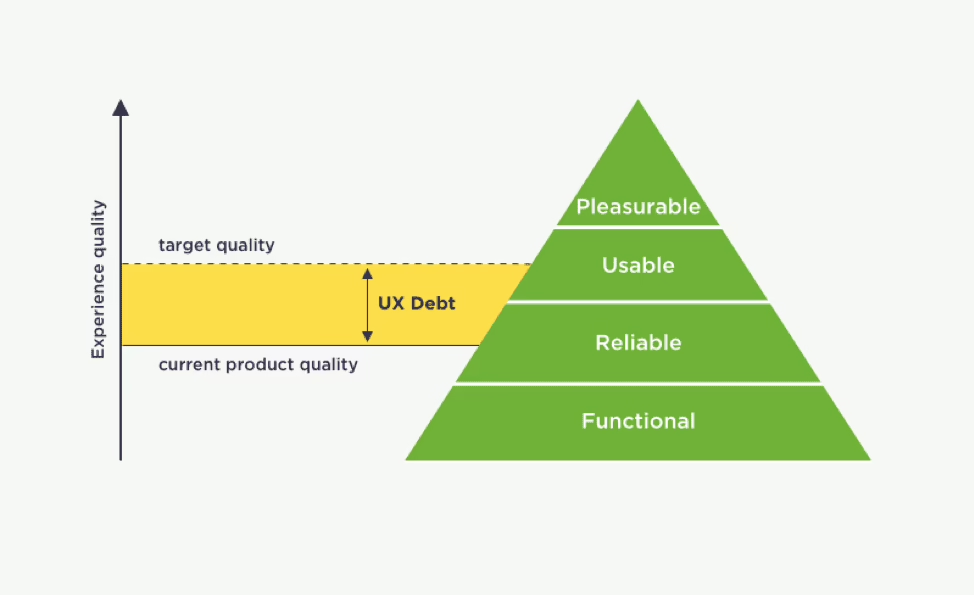In this digital world, great design isn’t just about looking pretty. It’s about creating smooth and delightful experiences for your users.
However, sometimes in the rush to launch new features or meet tight deadlines, design decisions are made on the fly. These quick fixes can build up over time into what we call UX design debt.
In this blog, we’ll explore what UX design debt is, how to identify it and share some tips to manage and even prevent it. So, grab a cup of your favorite beverage and let’s dive in.
What Is UX Design Debt?
UX design debt is a concept borrowed from the world of software development, where “technical debt” refers to the cost of additional rework caused by choosing an easy solution now instead of using a better approach that would take longer.
Similarly, UX design debt accumulates when compromises in design are made for the sake of speed, budget, or other pressures.
Key Points:
- Quick Fixes Add Up: Small design shortcuts like inconsistent buttons or confusing navigation might not seem like a big deal at first. But over time, these can snowball, making your product harder to use.
- Impact on Users: When UX debt accumulates, users may experience frustration, leading to increased support calls, lower engagement, or even lost customers.
- Costly to Fix: Just like financial debt, the more UX debt you accumulate, the more “interest” you pay in the form of time and resources needed to fix it later.
Understanding UX design debt is the first step toward keeping your product user-friendly and efficient.

Signs You Have UX Design Debt
How can you tell if your product is suffering from UX design debt? Here are some common red flags:
1. Inconsistent UI Elements
Ever notice buttons that look different from one page to the next? Or icons that don’t quite match the overall style of your app? Inconsistent design elements are a clear sign that shortcuts might have been taken during development. This inconsistency can confuse users and lead to a fragmented brand experience.
2. High User Friction
If your users are struggling to complete tasks, whether it’s a confusing checkout process or a maze of menus, it’s likely that design debt is to blame. High user friction can be measured through usability testing and user feedback, and it’s a major barrier to achieving a smooth user experience.
3. Increased Customer Support Tickets
A sudden spike in support queries about navigation issues, broken layouts, or non-intuitive workflows can indicate underlying UX problems. When users repeatedly encounter the same issues, it’s a sign that quick fixes in design have resulted in deeper, more systemic problems.
4. Poor Accessibility
Accessibility isn’t just about checking a box—it’s about ensuring that everyone, including people with disabilities, can use your product with ease. If your design doesn’t meet accessibility standards (like WCAG guidelines), you’re not only excluding potential users but also accumulating design debt.
5. Temporary Workarounds
Sometimes teams implement temporary design workarounds to meet deadlines. Over time, these “temporary” fixes can become permanent, leading to a messy, hard-to-maintain user interface. This patchwork approach is a classic hallmark of accumulating design debt.
Also read: Designing Data-Intensive Apps | 2025 Guide for UI/UX Designer

How to Identify UX Debt in Your Product
Identifying UX design debt isn’t always simple, but with the right approach, you can uncover hidden issues before they snowball. Here are some strategies to help you pinpoint the problem areas:
1- User Testing and Feedback Loops
Engage with Your Users:
One of the most effective ways to identify design debt is to ask your users directly. Regular user testing sessions can reveal pain points that aren’t immediately obvious from within the design team.
- Conduct Usability Tests: Invite a diverse group of users to complete specific tasks on your site or app. Observe their interactions and note where they hesitate or struggle.
- Feedback Forms & Surveys: Implement on-page surveys or feedback forms. Ask targeted questions like, “Was it easy to find what you were looking for?” or “Did anything confuse you during your visit?”
2- Analytics and Behavior Tracking
Let the Data Speak:
Sometimes, numbers can tell you more than words. Use analytics tools to track user behavior and identify drop-off points or areas of high exit rates.
- Heatmaps: Tools like Hotjar or Crazy Egg can show you where users click, scroll, or stop engaging. These visualizations can help pinpoint areas where the design might be causing confusion.
- Behavior Analytics: Use tools like Google Analytics to monitor metrics such as bounce rates, session durations, and conversion funnels. A sudden change in these metrics can be a red flag.
3- UX Audits and Heuristic Evaluations
Expert Eyes on Your Design:
Conducting a UX audit is like getting a professional tune-up for your product. Experienced UX designers can conduct heuristic evaluations using established principles to assess the usability of your design.
- Heuristic Evaluation: Review your product against Nielsen’s usability heuristics. This method can uncover a range of usability issues from consistency to error prevention.
- Design Reviews: Regularly schedule design review sessions where your team goes through the product and notes any inconsistencies or potential improvements.
4- Surveys and Usability Testing
Ask the Right Questions:
Create surveys that dig deep into user experiences. Open-ended questions can often reveal insights that quantitative data might miss.
- What Do Users Love? Find out what parts of your product users enjoy, as well as what they feel could be improved.
- Identify Pain Points: Ask users about specific moments in their journey where they felt frustrated or lost.
Managing UX Debt: Best Practices
Once you’ve identified the signs of UX design debt, it’s time to tackle the issues head-on. Here are some best practices to manage and reduce UX debt:
1- Prioritize Debt Based on Impact
Not All Debt Is Created Equal:
It’s crucial to assess which issues are having the biggest impact on your users and business outcomes.
- High-Impact vs. Low-Impact: Focus on fixing issues that directly affect user conversion and satisfaction first.
- Quick Wins: Identify “low-hanging fruit” that can be resolved quickly for an immediate boost in user experience.
2- Create a UX Debt Backlog
Track Everything:
Just as you’d manage a technical debt backlog, maintain a detailed list of UX issues.
- Document Every Issue: Use tools like Trello, Jira, or a simple spreadsheet to record each problem, along with its impact and urgency.
- Regular Reviews: Make it a habit to review and update the backlog regularly. This keeps your team aligned and focused on resolving issues progressively.
3- Collaborate Across Teams
Teamwork Makes the Dream Work:
UX design debt isn’t a problem for designers alone. It requires collaboration between designers, developers, product managers, and customer support.
- Cross-Functional Meetings: Regularly bring together different teams to discuss pain points and prioritize fixes.
- Shared Ownership: Ensure that everyone understands the importance of a seamless user experience. When all departments are on board, solutions can be implemented more smoothly.
4- Gradual Fixes vs. Full Redesigns
When to Patch and When to Overhaul:
There are times when you can apply small fixes incrementally and other times when a more radical redesign is necessary.
- Incremental Improvements: For minor issues, implement gradual changes that don’t disrupt the overall user experience.
- Complete Redesigns: When multiple issues are intertwined or the product feels outdated, consider a full redesign. While more resource-intensive, this approach can offer a fresh start and a more consistent user experience.
5- Build a Scalable Design System
Prevent Future Debt:
A robust design system is your best defense against accumulating UX debt.
- Consistent Components: Create a library of reusable components (buttons, forms, icons) that can be applied consistently across your product.
- Documentation: Keep detailed guidelines on how and when to use each component. This helps maintain consistency as your team grows or when new designers come on board.
- Regular Updates: As your product evolves, so should your design system. Regularly revisit and update your guidelines to ensure they remain relevant and effective.

Preventing UX Debt in Future Projects
While it’s important to manage existing UX design debt, preventing new debt from piling up is equally crucial. Here are some strategies to ensure a more sustainable design process:
1- Set Clear UX Guidelines from the Start
Lay the Foundation:
Before diving into any project, ensure that your team is aligned on a set of clear, concise UX guidelines.
- Define Standards: Establish design standards and best practices that everyone must follow.
- Onboarding Material: Create onboarding documents for new team members so they understand the design philosophy from day one.
2- Regular Design Reviews & Usability Testing
Stay Proactive:
Regular check-ins can help catch issues before they become major problems.
- Scheduled Reviews: Hold weekly or bi-weekly design review meetings to assess the current state of your product.
- Iterative Testing: Integrate usability testing at multiple stages of the design process. The sooner you catch a problem, the easier it is to fix.
3- Allocate Time for UX Improvements in Sprints
Plan for Improvement:
Incorporate UX enhancements as a regular part of your development cycle.
- Sprint Goals: Include UX improvements in your sprint planning sessions. This could be anything from fixing minor inconsistencies to implementing a new design component.
- Buffer Time: Allow for some buffer time in your project timelines specifically dedicated to addressing UX debt.
4- Continuous Learning and Adapting to User Needs
Never Stop Evolving:
The digital landscape is always changing, and so are user expectations.
- Stay Informed: Keep up with the latest UX trends and best practices. Attend workshops, webinars, and conferences to learn from industry experts.
- Feedback Loop: Maintain an ongoing dialogue with your users. Their feedback is invaluable in helping you stay ahead of potential design issues.
Bringing It All Together
Managing UX design debt is not about chasing perfection overnight—it’s about continuous improvement and ensuring that every change you make enhances the overall user experience. By understanding what UX debt is, recognizing its warning signs, and implementing a proactive strategy to address it, you set your product up for long-term success.
Key Takeaways:
- Identify Early: Use user testing, analytics, and expert reviews to catch UX issues early.
- Prioritize Fixes: Focus on high-impact areas first, and maintain a clear backlog of issues.
- Collaborate: Work closely with cross-functional teams to ensure that design improvements are well-integrated.
- Prevent Future Debt: Build scalable design systems, set clear guidelines, and maintain regular reviews to keep your design debt in check.
Remember, the goal isn’t to achieve a flawless design overnight, but to create a sustainable process that continually refines and improves your product’s user experience.
Conclusion
UX design debt can be a sneaky challenge, gradually undermining your product’s usability and customer satisfaction if left unchecked. However, with the right approach—regular audits, user feedback, cross-team collaboration, and a commitment to continuous improvement—you can manage and even prevent UX debt from accumulating.
By prioritizing user needs, setting clear guidelines, and leveraging a well-organized design system, you’re not just fixing problems—you’re building a foundation for a product that truly delights your users.
Ready to Tackle Your UX Design Debt?
If you’re feeling overwhelmed by design debt or need expert guidance on building a more cohesive user experience, remember that you’re not alone.
At Hapy Design, we specialize in helping teams streamline their UX with research-driven solutions and scalable design systems. Whether you need a quick audit or a full-blown redesign, we’re here to help you create a product that stands out for all the right reasons.
Feel free to reach out, and let’s work together to make your product’s user experience as delightful as possible.
